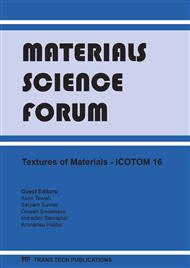p.68
p.76
p.80
p.85
p.89
p.93
p.97
p.101
p.105
Development of Microstructure and Texture in Al5052 Alloy Processed at Room and Cryogenic Temperatures in an ECAP Die
Abstract:
Development of microstructure and texture in alloy Al5052 deformed at room and cryogenic temperatures in an equal channel angular pressing (ECAP) die has been investigated. Billets were deformed using the Bc route up to 14 passes. Billets pressed at room temperature showed almost a 4 fold increase in the yield strength, which increased to about 320 MPa from about 90 MPa, while it increased to about 230 MPa in billets deformed at cryogenic temperature. At two deformation temperatures, grains were refined at more or less similar size reduction rate as a function of number of passes. However, for a given amount of strain, billets pressed at the two temperatures showed subtle differences in their microstructures and texture.
Info:
Periodical:
Pages:
89-92
Citation:
Online since:
December 2011
Authors:
Price:
Сopyright:
© 2012 Trans Tech Publications Ltd. All Rights Reserved
Share:
Citation:


